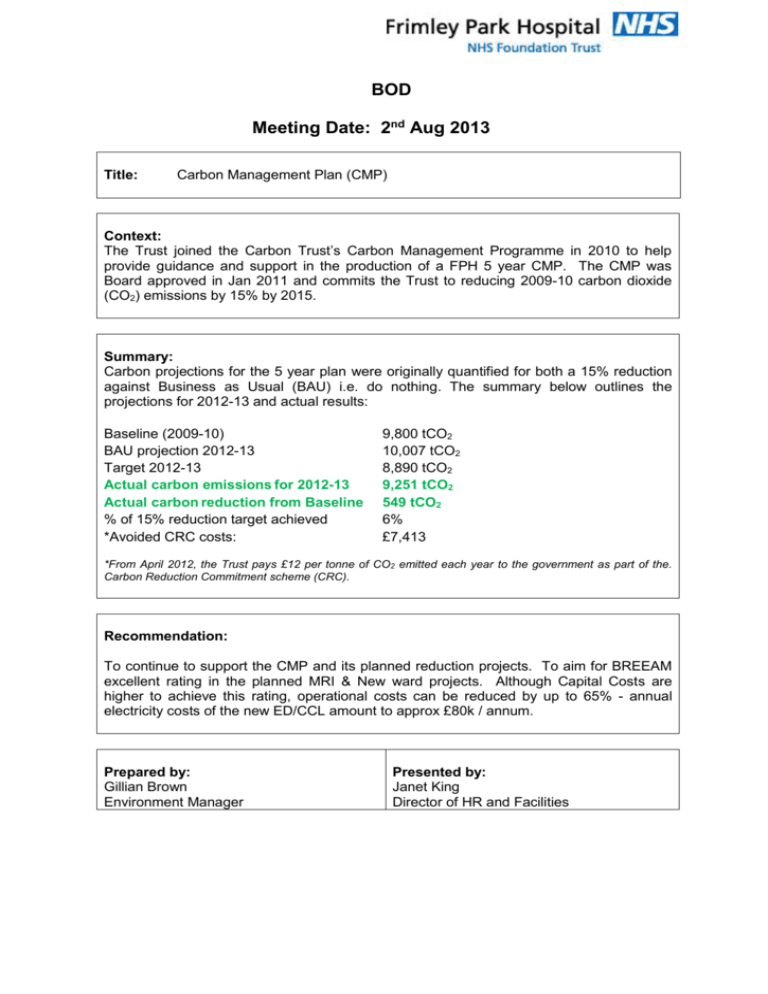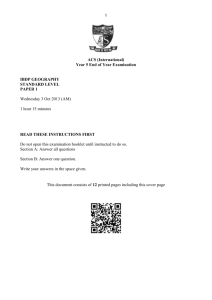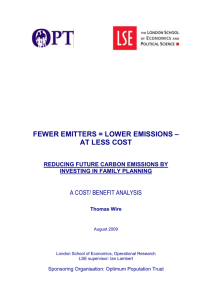The Trusts Project Plan for Carbon Management, Carbon
advertisement

BOD Meeting Date: 2nd Aug 2013 Title: Carbon Management Plan (CMP) Context: The Trust joined the Carbon Trust’s Carbon Management Programme in 2010 to help provide guidance and support in the production of a FPH 5 year CMP. The CMP was Board approved in Jan 2011 and commits the Trust to reducing 2009-10 carbon dioxide (CO2) emissions by 15% by 2015. Summary: Carbon projections for the 5 year plan were originally quantified for both a 15% reduction against Business as Usual (BAU) i.e. do nothing. The summary below outlines the projections for 2012-13 and actual results: Baseline (2009-10) BAU projection 2012-13 Target 2012-13 Actual carbon emissions for 2012-13 Actual carbon reduction from Baseline % of 15% reduction target achieved *Avoided CRC costs: 9,800 tCO2 10,007 tCO2 8,890 tCO2 9,251 tCO2 549 tCO2 6% £7,413 *From April 2012, the Trust pays £12 per tonne of CO2 emitted each year to the government as part of the. Carbon Reduction Commitment scheme (CRC). Recommendation: To continue to support the CMP and its planned reduction projects. To aim for BREEAM excellent rating in the planned MRI & New ward projects. Although Capital Costs are higher to achieve this rating, operational costs can be reduced by up to 65% - annual electricity costs of the new ED/CCL amount to approx £80k / annum. Prepared by: Gillian Brown Environment Manager Presented by: Janet King Director of HR and Facilities Carbon Footprint The below table and graph show the Trust’s CO2 emissions from 2009, which are now showing a steady decline. During 2010-11, the CMP was still being finalised, with few projects started/completed, however the decline in subsequent years demonstrates the reduction in CO2 from CMP planned projects and the CHP. The majority of the Trust’s carbon footprint can be attributed to gas and electric, which make up 94% of the Trusts emissions, with gas owning 77% of this figure. The 2012-13 figures show a deficit of 3% or 361 tCO2 to reach the interim 9% reduction target, which can be attributed to a variety of factors, mainly concerning gas useage: Unusually long cold winter Exportation of electric back to the grid starting Nov 2012 (CHP now running at full output) New builds (ED / CCL) Baseline t / CO2 2009-10 CMP 15% reduction target Actual reduction from Baseline Actual reduction from Baseline Actual reduction each year Avoided CRC costs 9,800 Target 9,800 Actual emissions 9,800 BAU 2010-11 -3% 1% 69 69 NA 9,487 9,869 9,869 CRC £ / tonne 2011-12 2012-13 -6% -9% -5% -6% -442 -549 -511 -107 £ 6,127 £ 1,286 9,183 8,890 9,358 9,251 9,938 10,007 2013-14 -12% £ 12.00 2014-15 -15% 8,605 10,077 8,330 10,148 Actual v Projected CO2 emissions t/CO2 12,000 10,000 Actual emissions 8,000 Target 6,000 BAU 4,000 2,000 2009-10 2010-11 2011-12 2012-13 2013-14 2014-15 2 Emissions (tCO2) 2009-10 2010-11 2011-12 2012-13 Difference Electric 4,285 2,083 1,701 1,404 -2881 Gas 4,622 7,245 6,851 7,085 +2463 Total 8,907 9,329 8,552 8,489 -418 Actual v Projected CO2 emissions Gas & Electric 10,000 9,000 8,000 7,000 6,000 Actual emissions Target t/CO2 Gas & Electric consumption All projects completed so far have targeted reductions in Gas and Electric, with an absolute reduction of 2881 tCO2 of electrical emissions since 2009. Gas emissions have risen by 2463 tCO2, primarily due to the introduction of the CHP, but the DH funded CHP project to link up more of the low grade heat should help to reduce Gas consumption further. Electric emits three times more CO2 than Gas and is the preferred energy use in terms of carbon reduction. 5,000 4,000 BAU 3,000 2,000 1,000 2009-10 2010-11 2011-12 2012-13 2013-14 2014-15 Gas & Electric spend The below table shows spend since the 2009-10 CMP Baseline. Additional Gas spend (blue columns) can be attributed to an unusually long winter, additional heating for the new builds and exportation of electricity to the grid. Electric spend (orange columns) in 2012-13 shows an increase in unit prices and total spend, which can be attributed mainly to the new ED & CCL. During the production of the CMP, an estimated additional 400tCO2 per year was advised, but not factored into targets at the time, as full planning permission had not yet been given for the projects to go ahead. Since 2008-09, energy prices have increased considerably, particularly electricity. Taking this into account and an increase in Gas consumption, in 2012-13 the Trust paid almost £130,000 less than in 2008-09 (green column). The BAU (yellow column) was projected in the original plan, and outlines what the Trust may have spent should no carbon reduction projects have taken place. Factors such as weather and (less so) new builds, have had a significant detrimental effect on utility spend in 2012-13 and the avoided costs projected. Avoided costs have been calculated by subtracting Total spend from BAU, which accumulate to £100k. The Trust would have hit its 9% carbon reduction target without the additional electricity required to run the ED and CCL (pink rows). Note – the ED spend is not a full FY. Summary of spend Electricity spend Difference year on year Ave cost per unit of energy 2008/09 £1,181,669 0 £580,700 2009/10 £696,117 -41% £655,376 2010/11 £352,499 -49% £0.08 2011/12 £339,231 -4% 2012/13 £346,841 2% Gas spend Difference year on year Ave cost per unit of energy BAU projection (do nothing) Total spend 0.023 £1,762,369 NA 13% 0.017 £1,351,493 Baseline £924,926 41% 0.017 £1,277,425 £1,398,579 £121,154 £0.09 £1,104,139 19% 0.020 £1,443,370 £1,483,012 £39,642 £0.14 £1,285,724 16% 0.029 £1,632,565 £1,572,543 -£60,022 Total avoided costs £100,774 Spend (£) % of total Electrical spend in 2012-13 Carbon (tCO2) ED (from July only) £65,660 19% 276 CCL £16,000 5% 66 2012-13 electrical contributions Avoided costs 3 Carbon reduction in 2013-14 Many projects were completed late 2012-13, which will be evident in 2013-14 figures, namely: Building management system upgrade Zoning of heating to provide better local control Window and door replacement programme Local lighting upgrades External car park lighting upgrade The carbon savings expected for the above projects hope to reduce CO2 emissions by approx 300 tCO2. Objectives for 2013-14 1. To install infrastructure to link up low grade heat from the CHP (DH £380k funding awarded for this.) 2. To embark on a joint staff awareness programme with Barts NHS Trust (DH £450k overall - FPH £107k funding awarded for this) 3. To sign the Trust up to the Good Corporate Citizenship scheme to help identify areas for further reduction. 4. To utilise Salix funding where criteria can be met. 5. To begin the process for producing a further 5 year reduction plan. The carbon savings expected for the above projects hope to reduce CO2 emissions by approx 600 tCO2, and combined with the projects completed in 2012-13 coupled with identified Salix projects should allow the Trust to meet its 15% reduction target by 2015. There are no financial repercussions associated with the CMP targets; these have been set internally by the Trust. The NHS as a whole has mandatory targets set to reduce its 2007 carbon footprint by 10% by 2015. Carbon Reduction Commitment (CRC) Public League Table - The Trust was ranked 9th best performing Trust in England for it’s 2011-12 carbon reduction emissions and 210th out of 2097 overall, which includes private and public sector organisations, mainly due to credits awarded from CHP electricity production. The credits have been revised for 2012-13 and we will no longer be able to claim a reduced cost. NHS rank (out of 162) 1 2 3 4 5 6 7 8 9 Overall rank (out of 2097) 6 33 46 79 134 190 199 203 210 Organisation NHS Blood & Transplant Nottinghamshire Healthcare NHS Trust Bradford Teaching Hospitals NHS Foundation Trust University Hospital of South Manchester NHS Foundation Trust Royal United Hospital Bath NHS Trust Mid Yorkshire NHS trust NHS Business Services Authority Imperial College Healthcare NHS Trust Frimley Park Hospital NHS Foundation Trust The Trust currently pays carbon tax at £12/tonne and is expecting to pay approx £120,000 for carbon emitted during 2012-13. The vast reduction in electrical consumption since the qualifying period (2008) now means the Trust is below the electrical consumption threshold for participation in CRC and will no longer be required to participate in CRC effective as of May 2014. The Trust will have one final payment in July 2014 to cover 2013-14 emissions, the cost of which may rise to £16/tonne of CO2. 4






